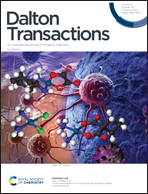Thermodynamics of metallocene catalyst activation: alignment of theory and experiment†
Abstract
Three equilibria involved in metallocene catalyst activation, including dissociation of R6Al2 (R = Me, Et or i-Bu) and related species such as [L2ZrMe2AlMe2][B(C6F5)4] (L2 = Cp2, 1,2-ethylenebis(η5-indenyl), Me2C(η5-C5H4)2) or [(L2ZrMe)2μ-Me][MePBB] (L2 = (h5-1,2-Me2C5H3)2, [MePBB]− = [MeB(ArF)3]− with ArF = o-C6F5-C6F4) are studied by DFT using various approaches to account for the enthalpy and entropy changes in gas and condensed phases. These studies reveal that both low energy vibrations and translational entropy conspire to cause significant deviations between theory and experiment when it comes to the free energy change in condensed or even gas phase. Alignment of theory with experiment requires in addition, consideration of specific solvation of reactants and products.

- This article is part of the themed collection: Nordic Collection


 Please wait while we load your content...
Please wait while we load your content...